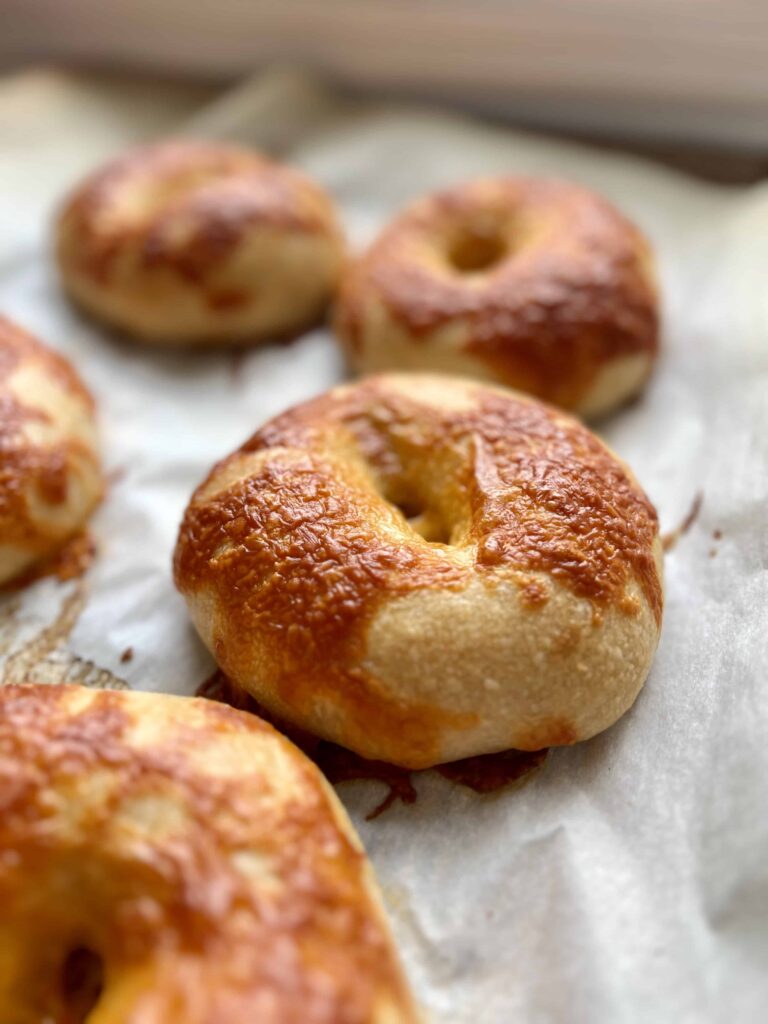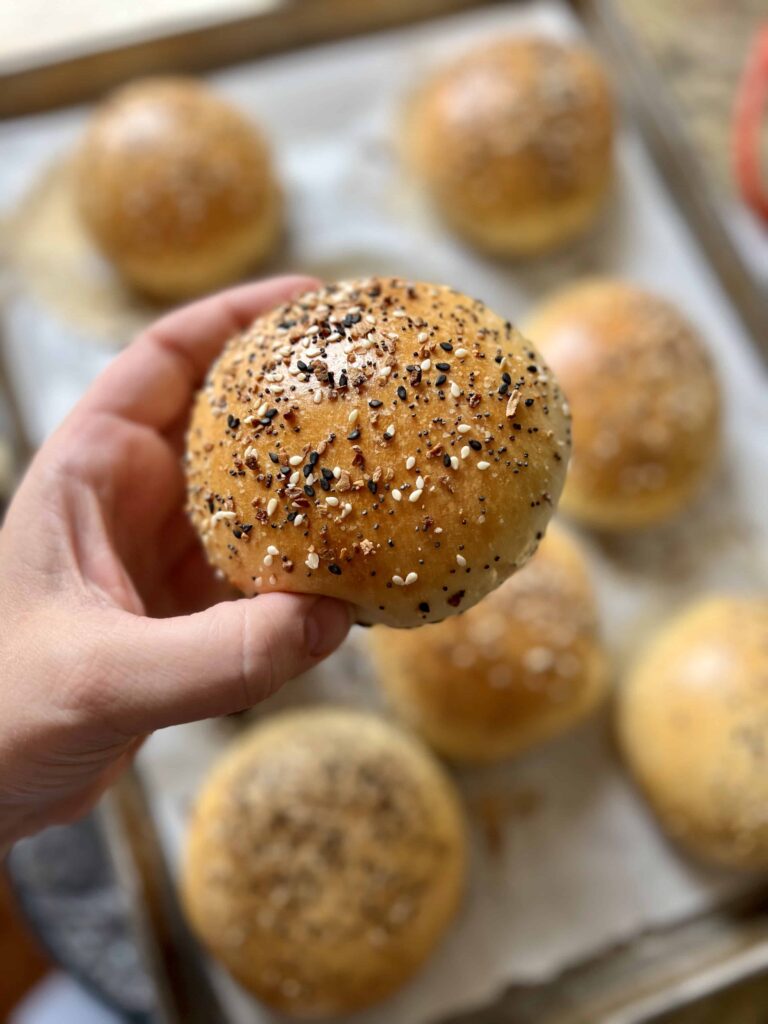Sourdough Brioche
This post may contain affiliate links. Please read our disclosure policy.Super soft, light, tender I almost don’t have words to describe just how incredible this sourdough brioche is. Tastes like a croissant but has the texture of a cloud? A pillow? The softest bread you’ve ever eaten – that’s this sourdough brioche. Made with 100% sourdough and a tangzhong, this is an advanced sourdough recipe that is going to give you amazing results. We love eating this plain or with a little bit of homemade jam. It’s also absolutely incredible as french toast and makes the perfect gift for a loved one. Seriously delicious, I hope you love this sourdough brioche as much as we do!

This is an advanced sourdough recipe. It requires using a stand mixer and will take a couple of days to make. If you’re looking for an easier soft sandwich bread recipe, check this recipe out here.
Ingredients in Sourdough Brioche
- Sourdough Starter: This recipe uses ripe, bubbly, active sourdough starter to make a sweet levain before mixing the brioche dough. Using a sweet levain balances the flavor, resulting in a mild sourdough brioche.
- Tangzhong: An Asian method of heating milk and flour over the stove until it forms a thick paste, is used in this sourdough brioche dough for a more tender, soft & soft crumb.
- Milk: Whole milk works best in this rich brioche.
- Sugar: Brioche is not overly sweet, but sugar helps to balance the flavors and bring a little sweetness to the dough.
- Eggs: Sourdough brioche is enriched with six large eggs. This gives the dough and resulting brioche a rich flavor.
- Salt: Salt is always added in bread dough to help balance the flavor and fermentation. Don’t leave it out!
- Bread Flour: I use bread flour in this recipe to get the gluten strands activated upfront with the initial mixing before adding butter. If you don’t have bread flour, you can substitute all purpose flour.
- Unsalted Butter: This recipe calls for a lot of butter. Unsalted butter doesn’t add any extra salt to the dough. The butter should be cool room temperature. You should be able to press your finger into the butter block and have it make an indentation, but the butter should not be soft. Butter is reserved and added to the dough after the dough has already been kneaded.
- Egg Wash: After the dough is shaped and proofed, a quick egg wash is used to top the the bread before baking.



Sourdough Sample Schedule for Sourdough Brioche
A sample baking schedule helps me when baking with sourdough. Sourdough takes much longer to rise than traditional bread. This schedule helps me plan my bake. Please Note: This schedule assumes the dough temperature is 78-80ºF throughout the process.
| Day 1 | Mix Levain/Mix Dough/Bulk Fermentation/Cold Fermentation |
| 8:00 AM-11:30 AM | Mix Levain. Let sit at 78 degrees F for about 3-4 hours until doubled/bubbly and ripe. |
| 10:30 AM | Mix tangzhong, let cool. |
| 11:30 AM -11:35 AM | Mix dough in stand mixer without butter |
| 11:35 AM – 12:00 PM | Add butter to dough and mix until windowpane (can take 20-30 minutes) |
| 12:00PM – 4:00 PM | Bulk Fermentation at 78-80ºF |
| 4:00 PM – 8:00 AM | Cold Fermentation |
| Day 2 | Shape, Proof and Bake |
| 8:00 AM -2:00 PM | Shape dough. Let rest/rise in a warm place until the dough has doubled, risen and is light and airy. This will take at least 6-7 hours at 80ºF. |

Mixing a Levain for Sourdough Brioche
1:1:1 Levain (ready in 3-4 hours/same day if kept at 78ºF): This recipe calls for a sweet levain mixed the same day before you mix the dough. It should take 3-4 hours to rise and peak if kept at 78-80ºF. Levain is ready when it has at least doubled in size, has lots of bubbles, a slightly sour aroma and is just about to start going down from its peak height. Mix together:
- 65 grams ripe/mature starter
- 65 grams warm water
- 65 grams all purpose or bread flour
- 15 grams granulated sugar
If you prefer to substitute ripe sourdough starter for the levain, this can work. Make sure your starter is 100% hydration (fed equal weights of flour and water) and is active and bubbly before using. Substitute for the levain in the recipe. You can also use this post on ratios to change up the ratio of feeding the levain to make it work for you and your schedule.

Why I use a Tangzhong for Sourdough Brioche
Tangzhong is a method used to make very soft bread. It originated in Japan and was made popular in Taiwan. To make a tangzhong, cook together milk and flour until it forms a thick paste. This is done on the stovetop over medium heat and comes together very quickly. As soon as it forms a paste, remove it from the heat and let it cool down before adding it to the brioche dough.
Tangzhong improves the dough’s texture and makes it stay fresh for longer. It produces delicious sourdough brioche.

Mixing Sourdough Brioche Dough
To make brioche, we first have to develop the gluten strands in the dough before we add in the butter. Once the butter is added, it coats the gluten strands, making it more difficult for the strands to connect and develop. To help with this process, we do an initial mix of all of the ingredients except the butter; adding the butter in after the dough is kneaded.
- Mixing: Add all the brioche ingredients together except for the unsalted butter. Turn the mixer on and knead for 5-7 minutes until a strong and cohesive dough is formed.
- Adding in butter: Once that dough has formed, begin adding in the butter. Butter should be added small chunks at a time until all the butter (three sticks of it) are incorporated. At this point, the dough is going to feel very slack and loose. When you take a pinch of it and pull up, it will break apart. Continue kneading the dough upwards of 20-30 minutes (you need a powerful mixer for this dough) until the dough has strengthened considerably and can pass the windowpane test. During this time, if the dough gets too hot from the friction of the mixer, take a break. Stick the dough in the refrigerator to cool it down and then continue mixing a few minutes later.
Windowpane Test: Stop the mixer. Pull up on a portion of the dough. The dough will stretch thinly and not tear and you will see light coming through the dough, like a windowpane. If it tears, the dough needs to mix longer.








Bulk Fermentation in Sourdough Brioche
Once the dough has passed the windowpane test, it will feel soft but cohesive. Take the dough out of the mixer and put it in a container to ferment. Keep the dough right around 78ºF to ferment for about 4-5 hours. If your dough temperature is cooler than 78ºF, it will need to ferment longer. You are looking for a very slight aeration of the dough during this time. It will not rise much, but it will become more aerated and strong as it ferments. If your dough temperature is higher 80ºF, be careful. You don’t want the butter to melt out of the dough, so cool the dough down as possible.

Cold Fermentation
Sourdough brioche dough benefits from a cold fermentation. Because this dough is so full of butter, it is difficult to work with when it’s not cold or chilled. Cover the dough and chill it overnight for a cold fermentation. The dough can stay in the refrigerator unshaped for up to 48 hours. If you don’t want to wait overnight, chill the dough for a minimum of 2 hours before shaping.

Shaping Sourdough Brioche Dough
Now for the fun part! I always love shaping dough, and this brioche dough is no exception. Check out this recipe for my easy overnight brioche (commercial yeast version) that has different shaping ideas. For this brioche, though, we are going to shape the dough into small balls and then let the dough rise to form a traditional brioche loaf. Pull out two 9 by 5 loaf pans. This is the perfect size for this brioche recipe.
Divide the dough in half. Work quickly because as the dough cools, the more difficult it is to work with. Divide each half into 8 balls. Take each piece of dough and pull/pinch up the sides until it forms a ball. Roll the ball on the counter, holding your hand in a cupping shape (see video here) to seal the balls and create tension. Place 8 balls in each loaf pan, nestling them next to each other. Cover the loaf pans with plastic wrap and place in a warm place to rise.







Final Brioche Rise
Brioche is an enriched dough AND this is a sourdough recipe, so your final proofing is going to take time. I put my brioche loaves in a bread proofer and set the proofer to 80ºF. With this constant temperature, my loaves rose in about 6-7 hours. You will notice a considerable rise in the dough. It will become airy and light. When you press in on one of the balls of dough, an indentation will be mostly left. All of these signs will let you know that your brioche is ready to bake. If you don’t have a bread proofer, do your best to keep your dough warm. If it isn’t warm, it will take a very long time to rise. Do NOT bake this dough if it has not shown a significant rise or else it will be dense and flat.





Baking Sourdough Brioche
Once the dough has risen, it is ready to be baked. Pre-heat the oven to 375ºF. While the oven preheats, whisk together an egg with a splash of heavy cream or water. Gently brush the tops of the brioche with the egg wash. This helps promote a brown crust on the top of your brioche loaves. Bake the loaves for 40-45 minutes until baked all the way through and the brioche registers 190-195ºF. Let cool completely before slicing and enjoy!





Frequently Asked Questions
Let it cool completely. Then slice, stick in an airtight bag and freeze. When you want a piece, let it defrost to room temperature or warm up just a little before enjoying.
You don’t have to use the tangzhong, but it makes a softer and more delicious brioche. If you are going to spend the time to make brioche, I think it’s worth it to spend a couple extra minutes to make the tangzhong. It makes the bread super soft and stay fresher for longer.
Brioche is delicious on its own, but we also like slicing it and adding some jam on top. Another favorite way to eat sourdough brioche is to slice it up and make it into french toast – best french toast you will ever eat!






If you liked this Sourdough Brioche, you may also like: Sourdough Cinnamon Sugar Babka / Buttery Sourdough Pull Apart Bread / Soft Sourdough Sandwich Bread / Rosemary Sourdough Bread / Whole Wheat Sourdough Sandwich Bread / Sourdough Cinnamon Rolls

Sourdough Brioche
Ingredients
Levain (1:1:1 about 3-4 hours at 78ºF)
- 65 grams sourdough starter ripe, bubbly, active
- 65 grams water
- 65 grams bread flour or all-purpose flour
- 15 grams sugar
Tangzhong
- 50 grams all-purpose flour
- 250 grams milk whole milk or 2%
Sourdough Brioche
- 180 grams ripe, bubbly, active levain
- all of the cooled tangzhong
- 45 grams milk, cold whole or 2%
- 90 grams granulated sugar
- 6 large eggs, cold about 300 grams
- 20 grams salt
- 750 grams bread flour
- 339 grams unsalted butter (3 sticks) cool but soft (when you press down, your finger should leave an indentation, but it is still relatively hard) – reserved for adding to the dough after 5 minutes of mixing
Egg Wash
- 1 large egg
- splash of heavy cream or water
Instructions
Mix Levain (1:1:1 about 3-4 hours at 78ºF)
- Mix together the ripe, active sourdough starter with bread flour, sugar and water until completely incorporated. Cover and let rise until doubled in size, bubbly and peaked.
Tangzhong
- About an hour before the levain is ready, whisk together 50 grams all-purpose flour and 250 grams milk in a saucepan. Place the saucepan over medium heat and cook, whisking constantly, until the mixture starts to thicken into a paste. This usually takes about 1-2 minutes. Quickly remove the thickened mixture from the heat and let cool before mixing your dough.
Sourdough Brioche
- Add Butter: Cut the butter into chunks, about 8-12 per stick of butter. Butter should be firm but soft enough to leave a dent when you press your finger into the butter. Turn the mixer on and add chunks of butter into the dough a little at a time. Continue adding chunks of butter until all the butter is added and incorporates into the dough.
- Knead until Windowpane: Continue kneading the dough on medium speed for 20-30 minutes (this will depend on your mixer and your dough) until the dough passes the windowpane test. To check for windowpane: Stop the mixer. Take your hands and pull up on a portion of the dough. At the beginning stages of kneading the dough, the dough will break as soon as you start to stretch it. As the dough kneads and the gluten strands develop, the dough will stretch thinly without tearing. You will know the dough is finished kneading when the dough does not tear when pulled and you can see light through the dough, like a windowpane. A word of caution: As you knead the dough, the friction from the mixer can heat up the ingredients in the bowl. It is important that the dough doesn't get too warm or else the butter will begin to melt and separate from the dough. If you notice this beginning to happen, take a break, stick your dough in the refrigerator to cool down and then continue kneading after the dough cools a little bit.
- Bulk Fermentation: At this point the dough will be very soft but also cohesive. Dump the dough into a container and cover. Set the dough in a warm, 78-80ºF place for 4 hours. Take the temperature of the dough as needed to make sure the dough temperature stays right around 78ºF. This temperature is the optimal fermentation. If your dough temperature is cooler than 78ºF, it will need to ferment longer than 4 hours.
- Overnight Refrigeration (Cold Fermentation): Stick the covered dough in the refrigerator overnight or up to 48 hours.
- Shape Loaves: Prepare two 9 by 5 loaf pans. Take the dough out of the refrigerator. Separate the dough into two equal pieces for two loaves of bread. Cut each loaf into 8 equal-sized pieces. Take each piece of dough and pull/pinch up the sides until it forms a ball. Roll the ball on the counter, holding your hand in a cupping shape (see video here) to seal the balls and create tension. Place 8 balls in each loaf pan, nestling them next to each other. See pictures in the post for details.
- Proof: Place the shaped loaves in a warm place to rise until doubled in size and light and airy. I proof my dough in a bread proofer and with the temperature set at 80ºF it takes about 6-7 hours for the dough to rise.
- Bake: Pre-heat the oven to 375ºF. Whisk together one large egg with a splash of heavy cream or water. Gently brush the egg wash on top of the risen dough. Bake for 40-45 minutes until the loaves are baked through and the internal temperature is 190-195ºF. Let cool completely before slicing. Enjoy!







Seriously. The. Best!! Thanks for making this for us! It is a top fave! 😍👩🏼🍳🍞
I tried making these and the flavors were on point but mine turned out very dense. Any thoughts as to what I did wrong?
If it was dense then it needed to rise longer. Make sure it’s rising in a warm place. The temperature of the dough should be around 80ºF throughout the entire bulk fermentation and proofing. The dough will double in size and be very light and airy feeling.
This looks super yummy. You mentioned that you can use ripe starter for the levain. So does that mean that you use 195 grams of starter mixed with the sugar and then you move on with the recipe from there?
You don’t mix it with the sugar. Just substitute ripe and active sourdough starter for the levain called for in the recipe.
Thank you!